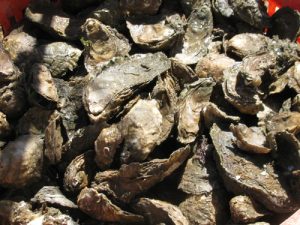
Mid-Atlantic oyster farmers have worked hard to achieve success with raising high quality oysters in large quantities.
The process begins with triploid oyster stock which are only about 2mm in length. Shellfish growers have experimented with a variety of strains, but the most common choice is usually some form of triploid stock.
Seed stock is usually started in early Spring, to avoid predation from water borne organisms. The oysters are nurtured in tanks until they are large enough to survive in cages.
The next stage begins as the young oysters are housed in mesh bags or cages which protect them from blue crabs, birds, and other predators. Depending on the operation, oysters are sometimes transferred into a larger container where they are allowed to grow until reaching market size.
A wide range of containers are used by Mid-Atlantic oyster aquaculture operations. Some operations ultilize on-bottom cages, in a variety of configurations. Other producers use floating versions, or suspended bags during the growth stage. Each type of container has its advantages and disadvantages.
At the harvest stage, oysters are brought to a facility, sorted, washed, and packed for shipment. Undersize oysters are returned to cages for grow out. Surplus shell material is usually retained and used in operations or sold as a separate product.
Related Information